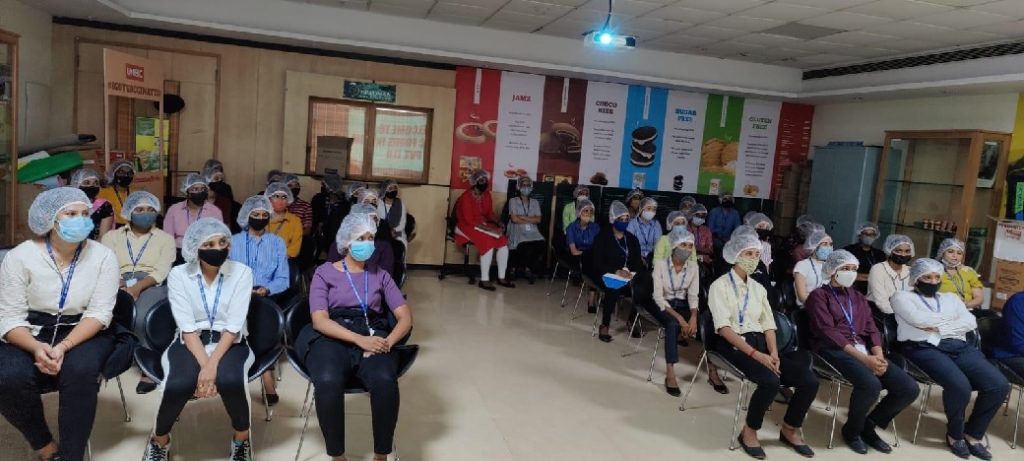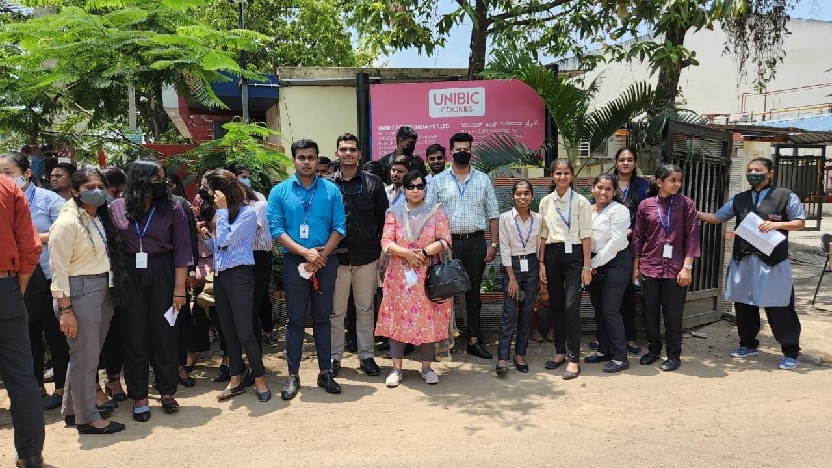INDUSTRIAL VISIT
Unibic Factory AlurNelmangala, Bengaluru





Date: 18.04.2022
Industrial Visit, has its own importance in a career of a student who is pursuing a professional degree. It helps to bridge the gap between classroom and the real working world. The visit also provides knowledge about the organizational structures and modes of operation in different industries. The MBA department of New Horizon College of Engineering had organized an Industrial Visit to Unibic Factory on 18th April, 2022. The 1st semester MBA students along with their respective class teachers were taken out for the Industrial Visit. The journey towards the Unibic Factory started at 9:30 AM and we reached the factory around 11:30 AM.
With the thought-provoking line “Why have a good day when you can have a great day!” they started their journey and by their delicious and delightful cookies, they have owned the heart of thousands. Unibic Foods Pvt. Ltd. started in 2004 and it’s headquarter is situated in Bengaluru. Initially, they had set up their business by importing cookies from Australia and by the end of 2005 they set up their manufacturing unit in India. There are a wide variety of cookies, they have developed over 20 varieties.They export to countries like UK, Korea, Australia, New Zealand, Middle East and many more. In India, it is more famous in southern part of India. There are totally 6 plants of Unibic cookies across India, there are 2 plants in Hyderabad which is the biggest plant among the 6 plants, 2 plants in Bengaluru ( Huskur Road &Bommasandra), 1 plant in Tumkur and 1 plant in West Bengal.
Manufacturing Process
The manufacturing process can be broadly classified into 4 steps, they are:
- Storage of raw materials
- Mixing of Ingredients
- Baking of Cookies
- Packaging and Warehousing
Storage of raw materials:
In order to ensure a continuous supply of raw materials at the mill, when some may only be seasonally available on the market, and to take advantage of price fluctuations, some form of storage will be necessary. Storage areas must be waterproof and well-ventilated, and provide protection against infestation by insects and vermin which can quickly cause substantial losses in weight. The proper storage of raw materials and of finished feeds is not only essential to prevent physical losses, but is also an important aspect of quality control.
Mixing of Ingredients:
The first step in manufacturing a cookie is the mixing of ingredients.Mixing is a process of blending together of ingredients to form a uniform mass. The method generally used is the
“Three stage method”, Shortening (Butter, margarine), Milk powder (SMP), Sugars (Sucrose crystals), Syrups (Liquid glucose), coconut powder, Biscuit powder, Brown Sugar, Emulsifier (Lecithin), Sodium Bicarbonate, Ammonium Bicarbonate, salt with water, Flour, Other cereals (oat) or chocolate chip or cashew.
Mixer Horizontal type of mixer is used, which contains agitator for proper mixing. Remove the dough from the mixer after completion of the mix. Roughly it takes 15 to 20 minutes for mixing all the ingredients. Wire cutting method is used to form pieces from more sticky dough and dough containing coarse particle such as nuts or oat flakes, that cannot be successfully rotary moulded.
There were totally 5 lines for mixing and cutting the dough.
Baking of Cookies:
It is a process of heating the moulded dough to a particular time and temperature combination resulting in evolution of gases (CO, NH) and evaporation of water to give the product its required body and texture. Baking in oven. The product is supported on a band which is usually a sheet of steel.
In the oven there were five zones they are Zone 1, Zone 2, Zone 3, Zone 4 and Zone 5. Expected temperature value for each zone has to be set which will have a corresponding actual value in each zone. In one of the ovens, the expected values for Zone 1, Zone 2, Zone 3, Zone 4 and Zone 5 were, 120, 140, 235, 190, 160 and the corresponding actual values were 106, 153, 243, 201, 161 respectively.
Since the cookies are baked at very high temperatures, they have to be cooled before packaging. The baked cookies are cooled through air so that the temperature of the cookies comes down. The cookies are allowed to cool, so that they not only take up the particular size but also to protect it from moisture uptake from atmosphere. There is appreciable loss of moisture during cooling and this is beneficial for cookies quality and shelf life.
Packaging and Warehousing:
The last and final step in the process is packaging. Packaging is the process of providing a protective and informative covering to the product in such a way that it protects the product during material handling, storage and movement. Packaging is done to protect contents against gain or loss of moisture, to protect against attack by insects, bacteria and other air borne contamination.
There are two types of packing: With tray and Without tray. The with tray type of packing is of the premium packets and the without tray type of packing are packets which is sold for Rs. 5 and Rs.10. In the packaging section both manual and machines are used. Arranging a pack of 10 cookies in the tray, is done manually. For packing the cookies, the machines are used. The number of packages to be done per minute by using machine is set by the operator.
Wrapping the packets in to a single pack is done using the machines. Then the packed packets are sent for warehousing. Storage Conditions of temperature and humidity are very important in cookies. From the warehouse, the cookies are sent for sales.
Conclusion
By visiting the Unibic factory helped us in gaining knowledge about the manufacturing process. Instead of only learning through theory the observation of the manufacturing process made the concept clear. The visit showed us that simplicity is an asset to any production unit and can be profitable if done right. This industrial visit has been opportunity to learn about the food industry and the manufacturing process involved in it. To be able to see the manufacturing process in action and to see the live application of knowledge acquires in the classroom was indeed eye opening. The sometimes-confusing part of the textbook were made clear and presented in a practical, logical and simple way.
We are thankful to them for providing us an opportunity to gain some practical and informative knowledge. We are also grateful to our HOD and the professors of the MBA department for this interesting and successful visit.

